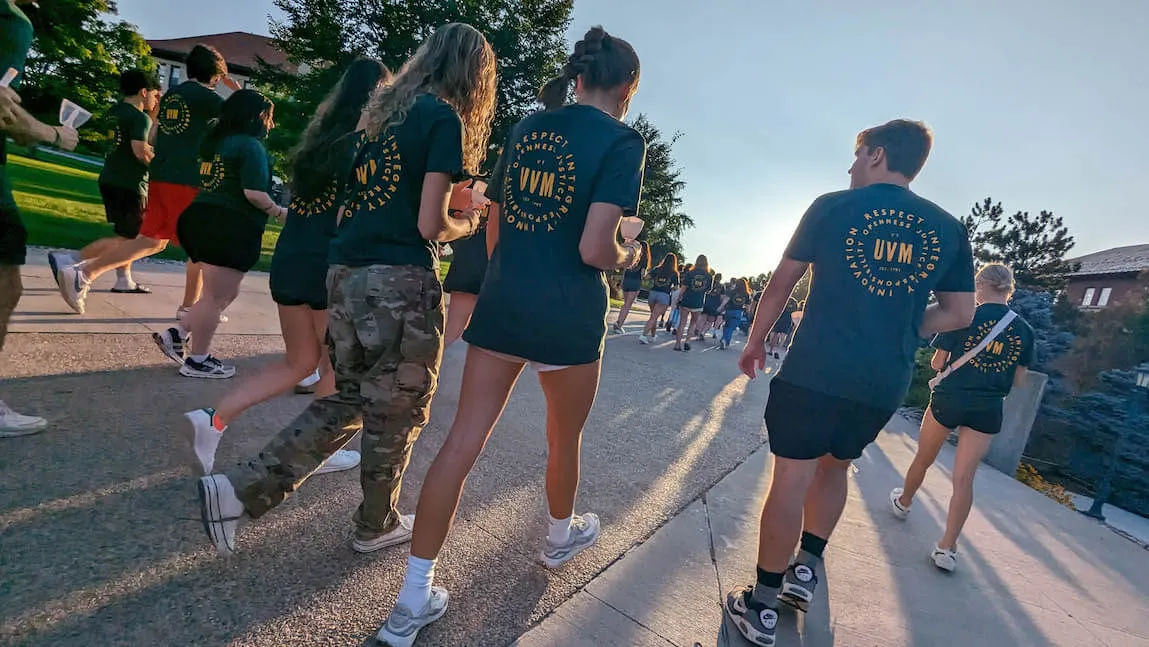August 28th marks the start of the Fall 2023 semester at the University of Vermont, following a successful move-in week and Sunday’s traditional Convocation and Twilight Induction ceremony.
The incoming class of 2027 is the most diverse group of new undergraduates in UVM’s history, with a 37% increase in international students over last year, a 16% increase in students who identify as BIPOC, and a higher percentage of first-generation college students. Fifty percent of the class is from outside New England, an indication of the university’s broadening national and international recognition and appeal — class members represent 45 states and 23 countries.
At the same time, UVM is welcoming more Vermont students, with a projected 10% increase in the number of undergraduate students from the state over last year. The UVM Promise, announced last fall, provides critical financial assistance to Vermont families trying to meet the cost of a quality education. This fall admitted undergraduate students from Vermont whose household adjusted gross income is $60,000 or less are receiving federal, state and institutional grants and scholarships to cover full tuition and the comprehensive fee.
One-hundred thirty-nine Vermont students are Catamount Commitment scholars, a program that covers tuition and fees for federal Pell Grant-eligible Vermonters. Thirty-nine are Green & Gold scholars, representing over 60% of the highest-achieving students in the state.
“It’s clear that interest in UVM is growing among high school students and their families within the state and across the country,” said President Suresh Garimella. “We place a strong emphasis on making a UVM education affordable for all, and we are pleased to have held our tuition at the same level for our students for a fifth consecutive year.”
UVM’s admission rate this year matches last year’s rate as the most selective in recent university history, again drawing from around 30,000 applications.
“The quality of our first-year students really reflects a growing recognition of UVM’s academic reputation among top high school performers,” said Vice Provost for Enrollment Management Jay Jacobs.
The incoming class brings an extraordinary range of talent to UVM. The newest undergraduate class includes:
• A Vermont student who was a co-captain of a Champlain Valley Union High School robotics team which won the state championship and represented Vermont in international competition;
• An international student athlete from England who is a neuroscience major and tends goal for the UVM field hockey team;
• A student from a rural village in southwestern Uganda who is now an accomplished debater holding national individual and team titles;
• A student from Texas who responded to the COVID pandemic by creating Mental Health Hopscotch, a researched-based art activity that helps young people improve their mental health;
• A student from Colorado who served as captain of his school’s rock climbing and bouldering teams and has climbed 47 of Colorado’s 58 14,000-foot summits.
The university’s new cohort of graduate students also continues the trend of increasing diversity and demonstrated preparation for success. The Graduate College oversees admissions for UVM's comprehensive offering of 56 master’s, 31 doctoral, and 13 certificate programs. This year, an increase in applications and a greater number of students selecting UVM over competitive admissions offers resulted in an overall graduate student population increase of roughly 5 percent.
“A particularly remarkable trend is the surging population of international students, representing the fastest-growing segment among our graduate students. This year, we expect a double-digit increase in students from outside the U.S.,” said Holger Hoock, the recently appointed dean of the Graduate College.
The international students hail from 40+ countries, with the largest populations coming from Iran, Ghana, Nigeria, and India, enriching UVM’s academic landscape and fostering a dynamic cross-cultural exchange of ideas and perspectives.
The new class for the University of Vermont’s medical school, the Larner College of Medicine, also reflects an increase in diversity and strong representation of Vermonters. Approximately 26% percent of the class is from Vermont; 24% are from backgrounds underrepresented in the medical profession; and 24% identify as LGBTQA students.
“For one of the smaller medical programs in the U.S., Larner attracts a remarkably diverse incoming class,” said Leila Amiri, associate dean for admissions at the medical college. “This year we have first-year students from 26 states and two Canadian provinces.”
